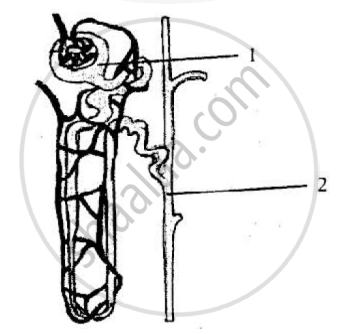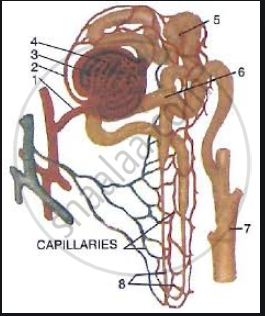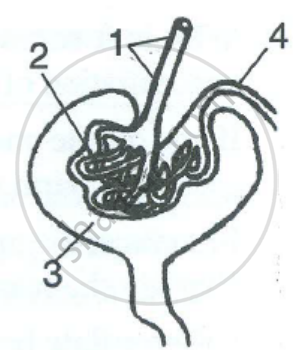Advertisements
Advertisements
प्रश्न
How is the amount of urine produced regulated?
उत्तर १
The amount of urine produced depends on the amount of excess water and dissolved wastes present in the body. Other factors, such as an organism's habitat and hormones such as Anti-diuretic hormone (ADH), also regulate the amount of urine produced.
उत्तर २
- The amount of urine produced is controlled by a hormone released from the posterior lobe of the pituitary gland, called antidiuretic hormone (ADH) or vasopressin. This hormone's role is to promote the reabsorption of water from the nephric filtrate.
- When there is sufficient water in the blood, less ADH is secreted, resulting in less water being reabsorbed from the nephric filtrate and, therefore, more urine is produced. Conversely, when there is less water in the blood, more ADH is released, leading to increased water reabsorption by the blood capillaries surrounding the nephron, which reduces the amount of urine produced.
APPEARS IN
संबंधित प्रश्न
What are the methods used by plants to get rid of excretory products?
Bile, Urea, Uric acid, Ammonia
Write the functions of Kidney
Write the functions of Ureter
Correct the following statements by changing the underlined words:
The normal pale yellow colour of the urine is due to the presence of the pigment Melanin.
The diagram given below is that of a structure present in a human kidney.
Study the same and answer the questions that follow:

1) Name the structure represented in the diagram
2) What is the liquid entering part ‘1’ called?
Name two substances present in this liquid that are reabsorbed in the tubule.
3) What is the fluid that comes to part ‘2’ called?
Name the main nitrogenous waste in it.
4) Mention the three main steps involved in the formation of the fluid mentioned in (iii) above
5) Name the substance which may be present in the fluid in part ‘2’ if a person suffers from Diabetes mellitus.
Fill in the following blank with suitable word:
Gums and resins are the .......... products of plants.
What does the bladder in our body do?
A dialysis machine contains long tubes coiled in a tank containing dialysing solution
What does the dialysing solution contain?
What is the function of excretory system in humans?
Where is urine carried through ureters?
The excretory unit in the human excretory system is called:
The organs A of a person have been damaged completely due to which too much of a poisonous waste material B has started accumulating in his blood, making it dirty. In order to save this person's life, the blood from an artery in the person's arm is made to flow into long tubes made of substance E which are kept in coiled form in a tank containing solution F. This solution contains three materials G, H and I in similar proportions to those in normal blood. As the person's blood passes through long tubes of substance E, most of the wastes present in it go into solution. The clean blood is then put back into a vein in the arm of the person for circulation.
(a) What are organs A?
(b) Name the waste substance B.
(c) What are (i) E, and (ii) F?
(d) Name G, H and I.
(e) What is the process described above known as?
Put a tick mark (✓) against the most appropriate alternative in the following statement :
In human beings, urea is produced in :
Fill in the blank :
Nitrogenous wastes in the urine are in the form of urea and .....................
Tick the most appropriate answer.
Quinine is used in the treatment of
Answer the following in short.
List five waste products of plants.
Answer the following in short.
Define transpiration in plants.
Name the following:
The part of kidney tubules where the term urine is first used for the fluid in it.
Fill in the blanks in the following passage to make it a meaningful description.
In a nephron, the ______ flows through the ______ under great pressure. The reason for this great pressure is that the ______ (outgoing) ______ is narrower than the ______ (incoming). This high pressure causes the ______ part of the blood to filter out from the ______ into the ______ capsule.
Define the following term :
Renal pelvis
Choose the odd one out in the following series:
Renal fat, renal capsule, nerve.
The following diagram represents a mammalian kidney tubule (nephron) and its blood supply.

Parts indicated by the guidelines 1to 8 are as follows:
1. Afferent arteriole from renal artery
2. Efferent arteriole
3. Bowman's capsule
4. Glomerulus
5. Proximal convoluted tubule with blood capillaries
6. Distal convoluted tubule with blood capillaries
7. Collecting tubule
8. U-shaped loop of Henle
Study the diagram and answer the question that follow:
Which structure contains the highest concentration of urea?
Study the diagram given alongside and then answer the question that follow:

Name the parts labelled 1, 2, 3, and 4.
Explain the functioning of kidney.
Given below is a simple diagram of the human kidney cut open longitudinally. Answer the following questions:
c
(v) Write two differences in the composition of the blood flowing through blood vessels A and B.
Explain the Term: Glomerulus
Name the Following
The branch of renal artery which enters into Bowman’s capsule.
Complete the following sentence with appropriate word:
The sum total of all the chemical reactions taking place in the cell is known as ______.
When uric acid is produced in excess, it gets deposited in joints, resulting in ____________.
The CORRECT match is ______.
What would happen if green plants disappeared from earth?
Leaves of a healthy potted plant were coated with vaseline. Will this plant remain healthy for long? Give reasons for your answer.
Name the following:
The main nitrogenous waste formed in the body.
Which of the following is not an example of secretion?
An organ that produces urea:
